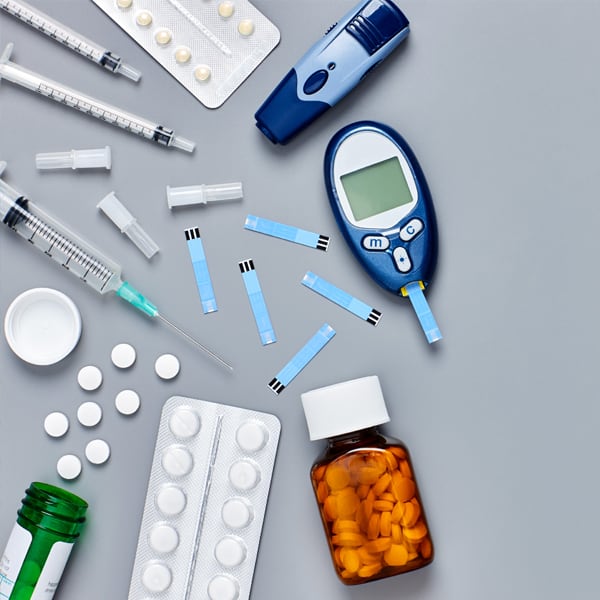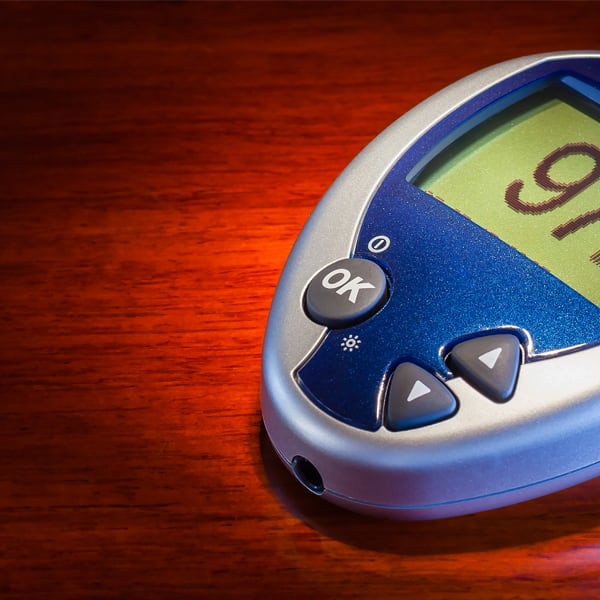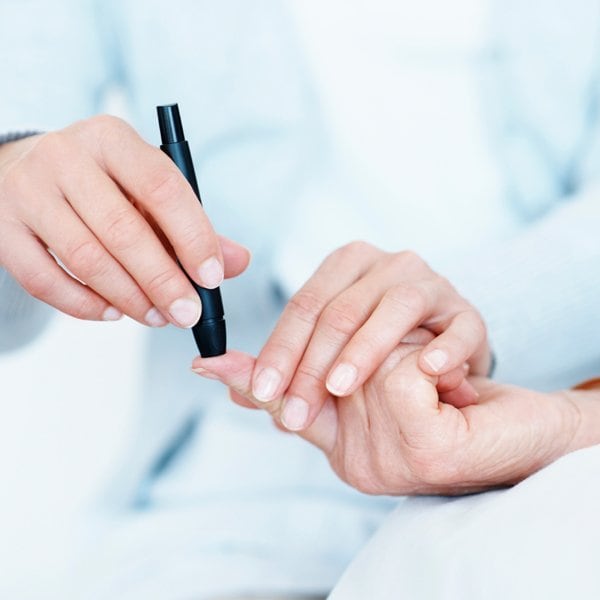Knowledge and resources for living with diabetes.
Living with diabetes means more than just watching your weight and levels. We have all the information and resouces for you to live a long happy life.

Featured Topics & Information
Diabetes is a serious illness, one that affects millions of people around the United States and the world. While it is sometimes preventable and even reversible, this is not always the case. The causes of diabetes are numerous, and because there are different types of the condition the potential for a cure and the kind of treatment needed both vary widely. Despite this, many people manage their diabetes successfully, and in some cases they reverse it completely and keep it at bay throughout the rest of their lives.
You’ll want to discuss with your doctor how to respond to your diabetes diagnosis. But being an informed patient demands that you learn about the condition and understand its implications and how to treat it properly.
Diabetes
A condition that prevents the body from producing and/or using insulin effectively. Type I, Type II, and gestational diabetes are different forms of this condition.
Diabetes Definitions
Part of understanding diabetes is knowing the meaning of common terms related to the disease. The better you know these terms, the better you can talk to your doctor about your concerns or questions.
Insulin
A blood sugar regulating hormone produced by the pancreas. This hormone is not produced in diabetes, or is not used correctly by the body.
Blood Sugar
The measure of sugar in the blood stream. Sugar can enter the bloodstream when the body releases it, and can also come from the digestion of food. Foods that have a lot of sugar or simple carbohydrates raise blood sugar (also called blood glucose) more than other foods.
The Three Types of Diabetes
There are three different types of diabetes. These are Type I and Type II, and gestational diabetes. These are all very different conditions, but they are also all similar in certain ways.
Type I Diabetes
In Type I diabetes, often also called juvenile diabetes, the pancreas, the organ that controls blood sugar in the body, doesn’t function correctly, most commonly because of an autoimmune response that destroys the cells in the pancreas that produce insulin. When the pancreas can’t produce enough insulin to handle extra blood sugar in the body, such as would come from eating sugary foods or carbohydrates, blood sugar levels rise and serious damage to the organs can occur over time. Type I diabetes is treatable through the use of insulin, but it is not curable, and it typically occurs in childhood.
Type II Diabetes
With Type II diabetes, there is a two-fold problem. The pancreas may not make insulin the way it should, but the body also has a reduced ability to process that insulin correctly, or at all. Because of that, there is not enough insulin to combat the incoming sugar and organs can’t use the insulin that the body is making effectively enough to offset the problem. That means blood sugar rises, but there are ways to address the problem that are not available in Type I diabetes. Diet and exercise are often effective in reducing Type II diabetes, as is losing weight. Medications may also be needed, but in some cases Type II diabetes can be reversed or cured. While this can occur in childhood, it is more common in older people and develops slowly, over time.
Prevention
Type I diabetes can’t be prevented, and in most cases neither can gestational diabetes, but many at risk of Type II can take steps to prevent it. This comes through diet, exercise, weight loss, and a healthy lifestyle, all of which can reduce the chances that a person will develop Type II diabetes. While it can often be reversed, the goal is to prevent it from ever occurring. Once it does, even if it’s reversed there will always be a higher risk of it. Instead of taking that risk, it is easier and safer for a person to keep diabetes at bay. Prevention can be helped along by working with your doctor, but it starts with you and the lifestyle changes you make in order to protect yourself and your long-term health.
When people are prediabetic, they need to make changes more quickly than people who have normal blood sugar. Prediabetes is a warning sign, and a reminder to take better care of yourself so you don’t end up sick. With that in mind, you’ll want to keep track of your blood sugar even if you don’t go to the doctor or have a blood test every year. You can buy a meter and test strips from a retail chain store or pharmacy for very little money, and this will allow you test your blood sugar at home and see whether it is high or low. Testing when waking can give you an idea of your fasting sugar, and you can also check it after meals to see how high it goes and how long it takes for it to come back down to more normal levels. With that information, you and your doctor will have a better idea of the best strategies for keeping you healthy.
Symptoms of Diabetes
Diabetes causes numerous symptoms before it causes complications, and if you notice these symptoms, you should go to your doctor and have your blood sugar tested. If you do have diabetes, you want to start treating and managing it as soon as possible to reduce the chances of it having a significant impact on your future quality of life. The most common symptoms of diabetes are:
- Excessive hunger or thirst
- Frequent urination
- Weight loss without trying
- Unexpected weight gain
- Fatigue or feeling tired
- Headaches in people who generally don’t have them
Testing
A doctor may have to run a series of tests in order to make a diagnosis of diabetes. The most common test for diabetes is checking the blood for sugar levels. In this test, a doctor, nurse, or technician pricks finger and uses a test strip and meter to get a blood glucose reading. Your doctor can also test your blood sugar when they take blood for other reasons, such as at a yearly physical. No matter which way your blood is tested, you’ll get a reading that will show whether your blood sugar level is high or not. Your doctor may ask you to fast first and take a sugar reading first thing in the morning. That’s the most accurate way to see how well your body is processing sugar.
For those who have Type I diabetes and some people who have Type II and must take insulin to control it, testing blood sugar several times a day may become standard. That can be especially important around mealtimes, because you’ll need to know how many units of insulin to take to balance out the meal you’re consuming. Testing is also important for long-term control, and a test called the A1c can provide you with a summary of how well your blood sugar control is doing over the course of a three-month period. That way you can see if you need to adjust your treatment, and if you take medication your doctor may have some suggestions to help you control your blood sugar better.
Diagnosis
A diagnosis of diabetes is serious, but it isn’t a reason to panic. There are many ways to control and treat it, depending on whether you have Type I, Type II, or gestational diabetes. If you aren’t a woman and aren’t pregnant, you can rule out gestational diabetes right away. If you’re past your teenage years, you can generally rule out Type I diabetes as well. While it’s possible for an older person to develop Type I diabetes, it’s far less likely to happen than it would be in someone who was much younger: most Type I diabetes diagnoses are made in people who are under 18 years of age. For older people, Type II diabetes is the usual diagnosis, though this condition can arise in younger people as well, especially if they are obese.
Once a diabetes diagnosis is made, treatment and care can begin, with the goal of potentially reversing it if it’s Type II. Type I must simply be managed and controlled, because there is no way to cure it. Gestational diabetes will generally resolve on its own after a woman gives birth, but it must be managed until that time. Type II diabetes, though, is a more complex illness, and will need to be managed and handled in a way that works best for the patient and provides the highest chance of reversal or control.
Treatment and Care
The treatment and care plan for diabetes will vary depending on what type of diabetes you have and your other risk factors and health conditions. For example, someone with gestational diabetes may simply have to wait until after they’ve delivered their baby before their condition will resolve itself. Until then, they may want to focus on a good diet and plenty of healthy exercise. They may lose weight (under their doctor’s supervision), or take steps to control how much weight they gain during their pregnancy. Some women may still need to take medication so they can stay healthy during their pregnancy and protect their growing baby.
For Type I diabetes, insulin is the treatment. This can come in the form of injections or through the use of an insulin pump. Not everyone will need a pump for their insulin, because that’s usually for very severe cases that can’t otherwise be controlled. Most Type I diabetics get by with insulin injections and frequent testing of their blood sugar. By working with their doctor, they can focus on the kinds of treatment options that are best for them and make sure they are feeling good, staying healthy, and taking the best possible care of themselves.
Type II diabetics have the largest range of treatment options. Some of them do need insulin injections, but most of them can take other types of medication (usually in pill form) in order to keep their blood sugar under good control. They can also focus on losing weight, improving their diet, and getting more exercise. This will boost their quality of life and reduce the risk of complications.
If you have diabetes of any kind, you’ll want to make sure you work with your doctor to seek proper treatment so you can stay healthy. By doing that, you’ll have the best chance at a good quality of life and proper management of your disease for a long time to come. While you can’t always avoid diabetes or its problems, you’ll always have steps you can take to prevent it and keep it at bay—and to enjoy the best health possible for the long term.
Risk Factors
There are specific risk factors for Type II diabetes, and for gestational diabetes as well. Type I diabetes doesn’t really have risk factors, but in the majority of cases, other types of diabetes can be controlled or avoided if the risk factors are controlled or avoided. Getting pregnant is the risk factor for gestational diabetes, as is being overweight, having a bad diet, or not getting any exercise. Additionally, Type II diabetes often occurs in people who don’t take good care of themselves, or who overeat, consume too much sugar, or are too sedentary. You can change a lot of these things with a different lifestyle and changes to your diet, which means that these are risk factors that are controllable. However, controlling for these factors is not a guarantee of avoiding Type II diabetes.
In some cases, people do everything right and still end up getting sick. They may eat healthy, get plenty of exercise, stay in a healthy weight range, and still end up with Type II diabetes. When that happens, medication may be the only way to control it. Despite that, though, combating the risk factors and avoiding them as much as possible is still worthwhile. Taking these steps can reduce the amount of medication needed and create fewer complications.
Long-Term Complications
There are many complications of diabetes, but many of them only occur over the long term. That can make treatment and management of diabetes difficult, because the person who has it may not feel sick or have any obvious symptoms or problems from their condition. When that’s the case they don’t always manage their diabetes the right way, and that can lead to problems months or years later. Once complications start to develop, however, it can be too late to fix the issue or correct the problems themselves, which can lead to significant changes to a person’s life. When people who have diabetes understand the seriousness of the condition and the long-term implications of poor management, they are much more likely to protect themselves.
Organ damage is among the main complications of diabetes, because of the high level of sugar in the blood. The extra blood sugar damages the arteries, which eventually causes restricted blood flow to the body’s organs and tissues, causing further damage over time. Eventually the organs start to fail. The kidneys are usually the first to have problems. Blindness is also an issue due to the reduction of blood flow to the eyes. This type of damage cannot be reversed, and depending on the severity of the damage, it may also be too late to stop it from getting worse, in which case total blindness (or kidney failure, or other types of organ failure) could be the result.
Strokes and heart attacks are also more common in people who have diabetes, especially if they fail to control it well. Over time, the damage to blood vessels from high sugar levels can result in hardening of the arteries, which is a major risk factor for strokes and related types of heart and arterial problems. With that in mind, people with diabetes will want to be more diligent in seeing their doctor and taking care of themselves.
Another long-term complication of diabetes is amputation. With the reduced blood flow to the body’s organs and tissues, diabetic people can have a lot of trouble with their feet and legs. Sometimes sores and other problems develop, and these can be slow to heal. That can lead to infections if not handled properly, and once that takes place, gangrene can become a real concern. Having toes, a foot, or even a leg amputated is not uncommon for someone with diabetes who doesn’t manage it well or correctly over the long term. While it can be frustrating to have to deal with a condition that isn’t causing immediate problems or significant symptoms, long-term management of diabetes is vital for reducing or avoiding long-term complications.
Gestational Diabetes
This is the only type of diabetes that is specific to women, as it occurs only when a woman is pregnant. Generally it resolves after the woman gives birth, but it does leave that woman more susceptible to Type II diabetes as she ages. If you’re pregnant, your doctor will test you for this type of diabetes to help protect you and your unborn baby. As with Type II diabetes, gestational diabetes can often be managed through diet and exercise under the direction of a doctor. Medication may be needed as well, though, because controlling blood sugar to protect the growing fetus is an essential part of managing gestational diabetes.
Prediabetes
A condition in which blood sugar remains elevated for a significant period of time, but not at the same levels, or for the same duration, as full-on diabetes. Having prediabetes is a a sign that the patient is at risk for full-blown Type II diabetes.
United States and World Statistics
While diabetes is treatable and controllable, there are also a large number of people who have it. Within the United States, 29 million people are believed to have diabetes. The number is not exact because 8 million of those individuals are undiagnosed, while the other 21 million have received a diabetes diagnosis. Throughout the world there are 422 million people living with diabetes. It is becoming a public health crisis and one of the largest chronic health conditions that people live with on a daily basis.
Many other people have prediabetes, where they are not yet diagnosed as diabetic but are still struggling to keep their blood sugar at an acceptable level. With prediabetes, fasting glucose levels are higher than normal, but not yet high enough to be considered officially diabetic. The high rates of prediabetes suggest that a large number of people will develop diabetes in the future if they don’t make changes to their diet, exercise, and weight range. This will cause an even larger spike in diabetes cases, and the numbers of people around the US and the world who have diabetes are expected to continue to rise.
Featured Articles
The Just One Step website is part of the National Diabetes Education Program (NDEP), which was created by the … Read more →
When women are pregnant, they can develop something called gestational diabetes. This is similar to Type II diabetes … Read more →
Having diabetes, whether it’s Type I or Type II, can be stressful. It can also be dangerous if you don’t manage … Read more →
There are a number of risk factors for diabetes, and, depending on the type, there are also ways to prevent the disease … Read more →
Diabetes can be a devastating illness. It’s the seventh-leading cause of death in the United States, causing more … Read more →
Both Type I and Type II diabetes require treatment and care to manage them effectively and reduce … Read more →
The National Diabetes Education Program’s Diabetes HealthSense has a goal: to provide people who struggle … Read more →
Thanks to the way diabetes is dramatized on television and in movies, many associate it with its more dramatic … Read more →
Having diabetes is a serious issue, but it’s not something that can’t be controlled. If you have Type I diabetes … Read more →
Whether you have Type I or Type II diabetes, there are several factors that could have contributed to the disease … Read more →
When you are first told you have Type II diabetes, it can be a scary time. You may not be sure how it happened … Read more →
When it comes to treating diabetes in children, one of the biggest concerns is how they will handle and … Read more →
Can’t Find the Answer You’re Looking For?
© 2017 YourDiabetesInfo.com All rights reserved.











